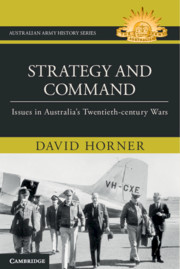Book contents
- Strategy and Command
- Other titles in the Australian Army History Series
- Acknowledgement of Country
- Strategy and Command
- Copyright page
- Contents
- Figures, maps and tables
- Preface
- Acknowledgements
- Abbreviations
- Introduction
- Chapter 1 The influence of the Boer War on Australia’s First World War commanders
- Chapter 2 Preparing for war, 1901–14
- Chapter 3 The AIF’s commanders
- Chapter 4 Strategic planning between the wars
- Chapter 5 Identifying the threat from Japan in 1941
- Chapter 6 A pivotal year in Australian history: 1942
- Chapter 7 Australia and coalition warfare in the Second World War
- Chapter 8 Deciding Australia’s war strategy in 1943
- Chapter 9 Advancing national interests
- Chapter 10 Higher command in the Korean War
- Chapter 11 Higher direction of the army in the Vietnam War
- Chapter 12 The Gulf War, 1991
- Chapter 13 Deploying and sustaining INTERFET in East Timor in 1999
- Chapter 14 Developing a command structure for joint operations
- Notes
- Bibliography
- Index
Chapter 2 - Preparing for war, 1901–14
Published online by Cambridge University Press: 08 October 2021
- Strategy and Command
- Other titles in the Australian Army History Series
- Acknowledgement of Country
- Strategy and Command
- Copyright page
- Contents
- Figures, maps and tables
- Preface
- Acknowledgements
- Abbreviations
- Introduction
- Chapter 1 The influence of the Boer War on Australia’s First World War commanders
- Chapter 2 Preparing for war, 1901–14
- Chapter 3 The AIF’s commanders
- Chapter 4 Strategic planning between the wars
- Chapter 5 Identifying the threat from Japan in 1941
- Chapter 6 A pivotal year in Australian history: 1942
- Chapter 7 Australia and coalition warfare in the Second World War
- Chapter 8 Deciding Australia’s war strategy in 1943
- Chapter 9 Advancing national interests
- Chapter 10 Higher command in the Korean War
- Chapter 11 Higher direction of the army in the Vietnam War
- Chapter 12 The Gulf War, 1991
- Chapter 13 Deploying and sustaining INTERFET in East Timor in 1999
- Chapter 14 Developing a command structure for joint operations
- Notes
- Bibliography
- Index
Summary
Late in the morning of Sunday 2 August 1914, following the receipt of various warnings from London that war was imminent, the Australian Prime Minister, Joseph Cook, met senior army officers in Melbourne to discuss ‘arrangements for putting the precautionary stage into operation’. The officers explained the plans, and immediately orders were issued for the first stage of mobilisation. The orders went out to the permanent gunners of the Royal Australian Garrison Artillery, as well as the permanent engineers, to man the defended ports at Thursday Island, Brisbane, Newcastle, Sydney, Melbourne, Hobart, Adelaide, Albany and Fremantle.
Keywords
- Type
- Chapter
- Information
- Strategy and CommandIssues in Australia's Twentieth-century Wars, pp. 27 - 44Publisher: Cambridge University PressPrint publication year: 2021

